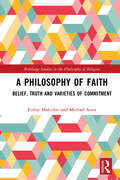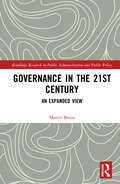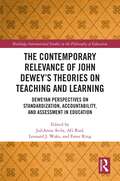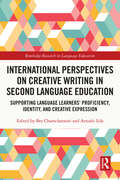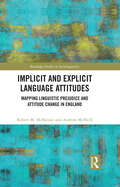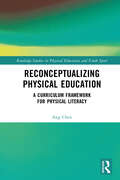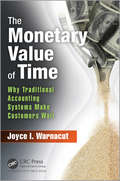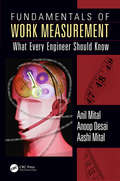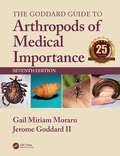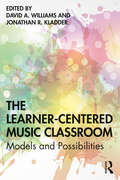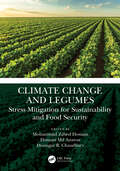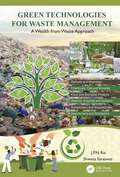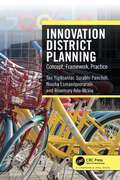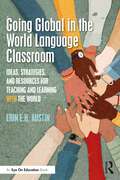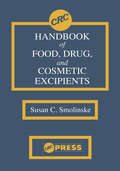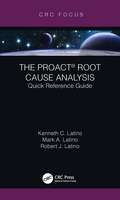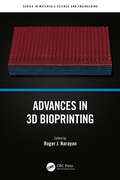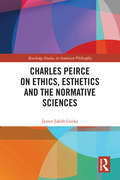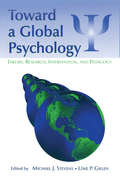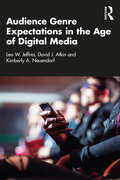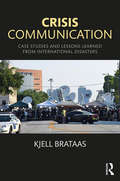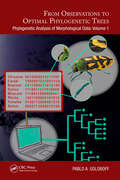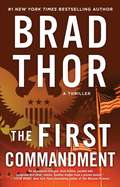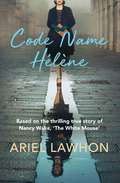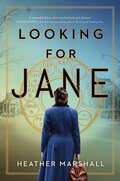- Table View
- List View
A Philosophy of Faith: Belief, Truth and Varieties of Commitment (Routledge Studies in the Philosophy of Religion)
by Finlay Malcolm Michael ScottFaith occupies an important place in human lives. It can be directed towards God, friends, political systems and sports teams, and is said to help people through crises and to motivate people to achieve life goals. But what is faith? Philosophers and theologians have, for centuries, been concerned with questions about the rationality of faith, but more recently, have focussed on what kind of psychological attitude faith is. The authors of this book bring together, for the first time, the different elements of this recent debate, staking out the different positions and arguments, and defending a novel ‘true grit’ theory of faith, from which the rationality and language of faith are addressed from a fresh perspective. The book engages with a range of questions about the nature of faith, including: Does faith require belief? Is faith motivational? What is the relationship between faith, trust and hope? Do expressions of faith aim at the truth? And, in what sense is faith resilient? The authors defend a distinctive conception of faith involving resistance to psychological, practical and epistemic challenges, from which a novel account of the psychology and epistemology of faith is developed. The treatment of the topic draws extensively on the philosophy of mind, language and religion, and provides a map of this exciting field of study for newcomers to the philosophy of faith. A Philosophy of Faith will appeal to researchers and advanced students in philosophy of religion, philosophy of mind, philosophy of language and epistemology who are interested in the topic of faith.
Governance in the 21st Century: An Expanded View (Routledge Research in Public Administration and Public Policy)
by Morris BosinIn Governance in the 21st Century, Morris Bosin offers an integrated approach in addressing real world governance challenges.Divided into four broad sections, Bosin begins in Part 1 by introducing the nature of governance, its use in the public and private sector, and at different levels in our society. Part 2covers traditional and emerging approaches to governance and reviews the various epistemological roots that frame our understanding of governance approaches. Part 3 includes a detailed discussion of the three components of his proposed approach to an expanded view of governance – requisite variety, complexity, and reflexivity. Part 4 illustrates the application of this approach through the use of case studies targeted at selected Federal agencies as well as at specific societal issues including the FDA's Drug Review Program, Bureau of Indian Education Program, U.S. Customs and Border Protection, COVID 19, and Police Department Strategies.Crossing traditional disciplinary lines, Bosin’s integrated approach will guide the academic community as well as practitioners toward a more holistic view of governance and offer generic solutions that can be adapted to any number of issues that portend transformational change for society.
The Contemporary Relevance of John Dewey’s Theories on Teaching and Learning: Deweyan Perspectives on Standardization, Accountability, and Assessment in Education (Routledge International Studies in the Philosophy of Education)
by JuliAnna ÁvilaThrough expert analysis, this text proves that John Dewey’s views on efficiency in education are as relevant as ever. By exploring Deweyan theories of teaching and learning, the volume illustrates how they can aid educators in navigating the theoretical and practical implications of accountability, standardization, and assessment. The Contemporary Relevance of John Dewey’s Theories on Teaching and Learning deconstructs issues regarding accountability mechanisms, uniform assessment systems, and standardization processes through a Deweyan lens. Connecting the zeitgeist of the era from which Dewey’s ideas emerged and current global political, social, and economic contexts, the book emphasizes the importance of resilient systems in reconciliating the tension between standardized assessments and individual student development. Contributors provide insights from a range of settings across Pre-K, primary, secondary, and higher education and address topics including teacher agency, voice, leadership, and democracy.The volume will be of interest to scholars, researchers, and academics with an interest in philosophy of education, education policy and the impact of neoliberal agendas, as well as teaching and learning more broadly.
International Perspectives on Creative Writing in Second Language Education: Supporting Language Learners’ Proficiency, Identity, and Creative Expression (Routledge Research in Language Education)
by Bee Chamcharatsri Atsushi IidaThis volume explores the instructional use of creative writing in secondary and post-secondary contexts to enhance students’ language proficiency and expression in English as a second or foreign language (ESL/EFL).Offering a diverse range of perspectives from scholars and practitioners involved in English language teaching (ELT) globally, International Perspectives on Creative Writing in Second Language Education tackles foundational questions around why fiction and creative writing have been traditionally omitted from ESL and EFL curricula. By drawing on empirical research and first-hand experience, contributors showcase a range of creative genres including autobiography, scriptwriting, poetry, and e-Portfolios, and provide new insight into the benefits of second language creative writing for learners’ language proficiency, emotional expression, and identity development. The volume makes a unique contribution to the field of second language writing by highlighting the breadth of second language users throughout the world, and foregrounding links between identity, learning, and ESL/EFL writing. This insightful volume will be of particular interest to postgraduate students, researchers, and academics in the fields of ESL/EFL learning, composition studies, and second language acquisition (SLA). Those with a focus on the use of creative writing in classrooms more broadly, will also find the book of interest.
Implicit and Explicit Language Attitudes: Mapping Linguistic Prejudice and Attitude Change in England (Routledge Studies in Sociolinguistics)
by Robert M. McKenzie Andrew McNeillThis timely volume constitutes the first book-length account of implicit as well as explicit language attitudes. It details the findings of a large-scale study, incorporating cutting-edge implicit and self-report instruments adapted from social psychology, investigating the evaluations of over 300 English nationals of the status and social attractiveness of Northern English and Southern English speech in England.The book is unique in its examination of implicit-explicit attitude divergence, across a range of social factors, to identify the direction of language attitude change in progress and the particular social groups leading attitude change. The volume provides a comprehensive understanding of language-based prejudice in England and the study paves the way for researchers to employ newly developed implicit and explicit measures to investigate language attitudes and language attitude change in a range of contexts.This book is invaluable for researchers in sociolinguistics and applied linguists interested in theoretical and methodological aspects of linguistic prejudice and language variation and change. It is also essential reading for social psychologists with an interest in attitudes, attitude change and prejudice.
Reconceptualizing Physical Education: A Curriculum Framework for Physical Literacy (Routledge Studies in Physical Education and Youth Sport)
by Ang ChenPhysical education curricula evolved to emphasize physical training, personal hygiene, character development, fitness development, sports competency, and health. These emphases led to different ways to conceptualize the curricula for primary and secondary schools. This book raises a need to re-conceptualize the physical education curriculum and proposes a life-scan perspective for physical education curriculum conceptualization. Reconceptualizing Physical Education proposes a conceptual framework to focus on the life journey of physical activity, which is guided by the monist perspective and a lifelong approach to physical literacy. Section I of the book lays out important theoretical articulation for a two-dimensional framework with the goal of educating the learner to take a lifelong perspective to personal health and physically active lifestyles. Section II presents curriculum frameworks designed for primary schools and secondary schools. In each framework chapter, the details of content and learning tasks are discussed in terms of the two-dimensional functions. Each framework may be used directly for curriculum development. The book is intended for curriculum scholars and researchers in physical education, graduate students in health and physical education curriculum studies, and teachers in physical education and health education. It may also be of interest of researchers and graduate students in kinesiology fields and public health.
The Monetary Value of Time: Why Traditional Accounting Systems Make Customers Wait
by Joyce I. WarnacutAlthough there are numerous books on alternative accounting methods, such as Lean accounting, none focus on the impact of time and how accounting practices can be modified to acknowledge the power of time. This book addresses this need.The Monetary Value of Time: Why Traditional Accounting Systems Make Customers Wait presents a framework for assessing the value of time in terms of organizational strategy and competitive advantage. The framework presented will enable organizations to develop consistent measures and ensure that their cost accounting system isn’t motivating behaviors that add to lead time and make customers wait.The framework outlined in this book is relevant to the managerial and cost accounting practices in today’s manufacturing environment, which is increasingly moving away from mass production to custom manufacturing. The framework is supported by high-level metrics, which are reinforced by operational metrics. This is supported by accounting data that recognize the value of time. Pricing models that incorporate the concept of time are presented. The book provides many examples of how the use of standard costing and traditional accounting practices in a high-mix/low-volume production environment can produce contradictory or even inaccurate results that form the basis for poor decisions that may actually move your organization farther from its objectives.The book arms readers with options for overcoming traditional barriers by applying direct costs at an item level, while applying overheads at a macro or value stream level. For example, while GAAP requires overhead application for inventory valuation, a common misconception is that overhead must be applied at an item level. In fact, overhead can be absorbed by one journal entry. Demonstrating the linkages between time-based accounting data and meaningful business metrics that drive bottom line results, the book presents methods and metrics that have been successfully applied by the author in manufacturing environments.
Fundamentals of Work Measurement: What Every Engineer Should Know
by Anil Mital Anoop Desai Aashi MitalThis book will provide a quick reference on Work Measurement. While the nature of the work may differ, measuring work is fundamental to any industrial or service activity. It’s needed to determine such things as the amount a person should be paid, how much time should it take to perform an activity, what is an acceptable days’ work, or how any two or more methods or designs compare. This book provides non-industrial engineers with the why and the how work is measured in order to perform their jobs.
The Goddard Guide to Arthropods of Medical Importance
by Gail Miriam Moraru Jerome Goddard IICovering all major arthropods of medical importance worldwide, this award-winning resource has established itself as a standard reference for almost 25 years. With the globilization of commerce and the world becoming more intimately connected through the everyday ease of travel, unknown arthropod species are being increasingly encountered. This means access to up-to-date, authoritative information in medical entomology has never been more important. Now in its seventh edition, this book maintains its well-acclaimed status as the ultimate easy-to-use guide to identify disease-carrying arthropods, the common signs and symptoms of vector-borne diseases, and the current recommended procedures for treatment. Includes an in-depth chapter with diagnostic aids to help physicians to recognize and accurately diagnose arthropod-related diseases and conditions more easilyUpdates all chapters with the latest medical and scientific findings, including Zika virus, red meat allergy, new viruses found in ticks, and vaccine development for malaria and dengue feverPresents a greater medical parasitology emphasis throughout Offers electronic downloads containing additional photographs of arthropod-caused diseases and lesions, as well as instructional videos with pest identification aids, basic entomology, and insect and pest ecology.Illustrated throughout with detailed color images to aid identification, The Goddard Guide to Arthropods of Medical Importance, Seventh Edition will remain an essential guide for physicians, public health officials, and pest control professionals.
The Learner-Centered Music Classroom: Models and Possibilities
by David A. Williams Jonathan R. KladderThe Learner-Centered Music Classroom: Models and Possibilities is a resource for practicing music teachers, providing them with practical ideas and lesson plans for implementing learner-centered pedagogical concepts into their music classrooms. The purpose of this book is to propose a variety of learner-centered models for music teaching and learning through the use of a variety of autoethnographic viewpoints. Nine contributors provide working and concrete examples of learner-centered models from their classrooms. Offering lesson plan ideas in each of these areas, the contributors provide practical approaches for implementation of learner-centered approaches in music instruction across a variety of landscapes.Learner-centered teaching provides an approach to music education that encourages social, interactive, culturally responsive, creative, peer-based, open-formed, facilitated and democratic learning. Chapter 1 defines the what, why, and perceived benefits of learner-centered approaches in music teaching and learning contexts Chapters 2-10 will include example lesson plans, rubrics, etc. as models for teachers. The contributors to this book suggest that learner-centered approaches, when embedded into the culture and curricular framework of a music classroom, offer exciting approaches for teaching music in ways that are culturally and educationally appropriate in contemporary education.
Climate Change and Legumes: Stress Mitigation for Sustainability and Food Security
by Mohammad Zabed Hossain Hossain Anawar Doongar R. ChaudharyGlobal climate change has created unprecedented challenges for human civilization due to its widespread adverse consequences, including a reduction in crop yield and threatening food security across the globe. Among the crop plants, legumes have great potential for ameliorating global warming since they can reduce carbon emissions by lowering reliance on the application of chemical fertilizers, by increasing nitrification and carbon sequestration in soil, and by providing protein-rich diets to both humans and livestock. This book identifies the extent of climate-induced stresses on legume plants and focuses on achieving food security through sustainable agricultural practices.This book compiles recent research findings and reviews on climate-related problems, the potential of legumes in ameliorating the impacts of climate change, as well as better management of agricultural land and practices for achieving environmental sustainability and food security.This book will serve as guidelines for scientists, agricultural practitioners, and policymakers working to achieve food security and better management of climate-induced stresses in agricultural interventions. It will also be useful as a reference book for researchers and students of both graduate and postgraduate levels. Furthermore, this book will provide enhanced knowledge about the mechanisms of yield and stress tolerance of legumes as well as developing climate-smart crops and improving cropping systems for a sustainable environment and food security. Features of the book Reviews trends of global climate change and its consequences for food security across the continents Identifies the challenges and scopes of cultivating legumes in achieving food security in the context of global climate change Focuses on the improvements of legume production through conservation approaches in agricultural practices and modern techniques, including omics-based breeding, biotechnology, genetic engineering, and rhizobium technology Discusses the sustainable amelioration options for soils affected by climate-induced stresses Cites examples of applications of rhizobium technologies in reducing greenhouse gas emission Describes pathways associated with yield, resistance, and tolerance of legumes to climate-induced stresses
Green Technologies for Waste Management: A Wealth from Waste Approach
by J.P.N. Rai Shweta SaraswatProper waste disposal is still a serious concern worldwide. This book addresses various types of wastes such as industrial, agricultural, and municipal solid and liquid wastes, their generation, and the status of waste management in developed and developing countries. It discusses advanced green technologies used in harnessing energy and bioproducts from wastes such as electricity, biofuel, biopolymers, fertilizers, and chemicals without damaging the quality of the environment but rather creating a source that is an added value to the environment. Through many applications and case studies, this comprehensive book helps readers build a state-of-the-art knowledge on waste utilization and energy generation.FEATURES Provides a comprehensive, state-of-the-art coverage of waste management practices, their challenges, and solutions from a global perspective Discusses conceptual principles and practices of various green technologies that can be used to generate valuable products from waste and improve environmental quality Includes case studies from the United States and Japan, providing detailed explanations of advanced bioremediation technologies Takes a holistic approach to waste management and bioproducts recovery Offers an easy-to-understand and target-oriented approach that helps both students and professionals advance their knowledge in creating wealth from waste Written for undergraduate and graduate students taking courses in environmental biotechnology, environmental microbiology, non-conventional energy sources, waste treatment technologies, environmental waste utilization, energy, and environment taught in universities and colleges. The book can also be used by professionals and researchers at different levels in related fields.
Innovation District Planning: Concept, Framework, Practice
by Tan Yigitcanlar Surabhi Pancholi Niusha Esmaeilpoorarabi Rosemary Adu-McVieThis book aims to fill the knowledge gap on how to plan, develop and manage innovation districts that are competitive in terms of both productivity and quality of living, justifying the massive investment put into place and at the same time doing both in a delicate and harmonious way.There is a need for smart urban land use that is wired with both hard infrastructures (e.g., telecommunication and transport) and soft infrastructures (e.g., diversity and tolerance). The reader learns this knowledge through conceptual expansions for key insights, frameworks for potential and performance assessment and best practices for global innovation districts. The authors begin innovation district planning with the role and effectiveness of planning a branding in the development of innovation districts. The next key topic of place making is recognised as a key strategy for supporting knowledge generation and innovation activities in the contemporary innovation districts. Another important topic is place quality where the reader learns to identify and classify indicators of place quality by studying global innovation districts best practices. The reader also expands their understanding on the classification of innovation districts based on their key characteristics through a methodological approach. The book concludes with district smartness studied through the socio-cultural role played by anchor universities in facilitating place making in innovation districts. Smart campuses, enabled by digital transformation opportunities in higher education, are seen as a miniature replica of smart cities and serve as living labs for smart technology.The book serves as a repository for scholars, researchers, postgraduate and undergraduate students as it communicates the complex innovation district phenomenon in an easy-to-digest form by providing both the big picture view and specifics of each component of that view.
Going Global in the World Language Classroom: Ideas, Strategies, and Resources for Teaching and Learning With the World
by Erin AustinWith this practical resource, you’ll learn how to promote global readiness and build international connections in the world language classroom. Master educator Erin E.H. Austin shares original strategies to facilitate productive language learning and demonstrates how to foster a rigorous, inclusive, and enriching environment. Designed to improve student motivation and engagement, the book is a shift from teaching about the world to teaching with the world. You’ll come away with plenty of inspiring and effective ways to not only invite the world into the classroom but also bring the classroom to the world and, in so doing, support an inviting classroom environment.The book abounds with low-cost, ready-to-implement tools, activities, and lesson ideas. The approaches in this book include coordinating international and world language events at school, using online resources to connect students to new languages and cultures, and broadening student horizons through books and podcasts. Austin also offers ways that further develop students’ global education through travel and study abroad opportunities. With this book, your students will become culturally literate, motivated language learners who will be ready to enter the global community and continue to learn from and with the world.
CRC Handbook of Food, Drug, and Cosmetic Excipients
by Susan C. SmolinskeCRC Handbook of Food, Drug, and Cosmetic Excipients provides a comprehensive summary of toxicological issues regarding inactive ingredients in pharmaceutical products, cosmetic products, and food additives. Background information on regulations and labeling requirements for each type of product is provided, and 77 articles critically review human and animal data pertinent to a variety of agents and makes judgments regarding the clinical relevance. The book also identifies at-risk populations, such as neonates, patients with renal failure, and atopic patients. Inactive common pharmaceutical agents and/or foods containing certain ingredients are listed to help physicians counsel hypersensitive patients who must avoid products containing these excipients.
The PROACT® Root Cause Analysis: Quick Reference Guide (Reliability, Maintenance, and Safety Engineering)
by Kenneth C. Latino Mark A. Latino Robert J. LatinoRoot Cause Analysis, or RCA, "What is it?" Everyone uses the term, but everyone does it differently. How can we have any uniformity in our approach, much less accurately compare our results, if we’re applying different definitions? At a high level, we will explain the difference between RCA and Shallow Cause Analysis, because that is the difference between allowing a failure to recur or dramatically reducing the risk of recurrence.In this book, we will get down to basics about RCA, the fundamentals of blocking and tackling, and explain the common steps of any investigative occupation. Common investigation steps include: Preserving evidence (data)/not allowing hearsay to fly as fact Organizing an appropriate team/minimizing potential bias Analyzing the events/reconstructing the incident based on actual evidence Communicating findings and recommendations/ensuring effective recommendations are actually developed and implemented Tracking bottom-line results/ensuring that identified, meaningful metrics were attained We explore, "Why don’t things always go as planned?" When our actual plans deviate from our intended plans, we usually experience some type of undesirable or unintended outcome. We analyze the anatomy of a failure (undesirable outcome) and provide a step-by-step guide to conducting a comprehensive RCA based on our 3+ decades of applying RCA as we have successfully practiced it in the field. This book is written as a how-to guide to effectively apply the PROACT® RCA methodology to any undesirable outcome, is directed at practitioners who have to do the real work, focuses on the core elements of any investigation, and provides a field-proven case as a model for effective application. This book is for anyone charged with having a thorough understanding of why something went wrong, such as those in EH&S, maintenance, reliability, quality, engineering, and operations to name just a few.
Advances in 3D Bioprinting (Series in Materials Science and Engineering)
by Roger J. Narayan"3D bioprinting" refers to processes in which an additive manufacturing approach is used to create devices for medical applications. This volume considers exciting applications for 3D bioprinting, including its use in manufacturing artificial tissues, surgical models, and orthopedic implants.The book includes chapters from leaders in the field on 3D bioprinting of tissues and organs, biomedical applications of digital light processing, biomedical applications of nozzle-free pyro-electrohydrodynamic jet printing of buffer-free bioinks, additive manufacturing of surgical models, dental crowns, and orthopedic implants, 3D bioprinting of dry electrodes, and 3D bioprinting for regenerative medicine and disease modeling of the ocular surface.This is an accessible reference for students and researchers on current 3D bioprinting technology, providing helpful information on the important applications of this technology. It will be a useful resource to students, researchers, and practitioners in the rapidly growing global 3D bioprinting community.
Charles Peirce on Ethics, Esthetics and the Normative Sciences (Routledge Studies in American Philosophy)
by James Jakób LiszkaThis book presents a comprehensive and systematic picture of Charles Peirce’s ethics and aesthetics, arguing that Peirce established a normative framework for the study of right conduct and good ends. It also connects Peirce’s normative thought to contemporary debates in ethical theory.Peirce sought to articulate the relation among logic as right thinking, ethics as good conduct and, in an unorthodox sense of aesthetics, the pursuit of ends that are fine and worthy. Each plays an important role in ethical life. Once aesthetics has determined what makes an end worthy and admirable, and ethics determines which are good and right to pursue, logical and scientific reasoning is employed to figure the most likely means to attain those ends. Ethics does the additional duty of ensuring that the means conform to ideals of conduct. In the process, Peirce develops an interesting theory of moral motivation, an account of moral reasoning, moral truth, and a picture of what constitutes a moral community.Charles Peirce on Ethics, Esthetics and the Normative Sciences will be of interest to scholars and students working on Peirce, American philosophy, and metaethics.
Toward a Global Psychology: Theory, Research, Intervention, and Pedagogy (Global and Cross-Cultural Psychology Series)
by Michael J. Stevens and Uwe P. GielenToward a Global Psychology defines the emerging field of international psychology. It provides an overview of the conceptual models, research methodologies, interventions, and pedagogical approaches that are most appropriate to transnational settings.
Audience Genre Expectations in the Age of Digital Media
by Leo W. Jeffres David J. Atkin Kimberly A. NeuendorfThis volume bridges the divide between film and media studies scholarship by exploring audience expectations of film and TV genre in the age of digital streaming, using qualitative thematic and quantitative data-driven analyses. Through four ground-breaking surveys of audience members and content creators, the authors have empirically determined what audiences expect of various genres, the extent to which these definitions match those of scholars and critics, and the overall variation and complexity of audience expectations in the age of media abundance. They also examine audience habits and preferences, drawing from both theory and original empirical analyses, with a view toward the implications for the moving image in a rapidly changing media environment. The book draws from the data to develop a number of new concepts, including genre repertoire, genre hybridity, audience interest maximization, and variety seeking, and a new stage of genre development, genre bending. It is an ideal resource for students and scholars interested in the symbiotic relationship between audiences and the moving image products they consume, as well as the way the current digital media environment has impacted our understanding of film and TV genres.
Crisis Communication: Case Studies and Lessons Learned from International Disasters
by Kjell BrataasCrisis Communication is an in-depth examination of recent tragedies and natural disasters that have occurred around the globe.The book covers three types of incidents: natural catastrophes, accidents and terror attacks. It focuses on the communication aspect of each incident and provides accounts from people handling the event. Each chapter offers a detailed description of the event and supplementary facts and illustrations from a variety of sources. With a focus on critical communication elements and lessons learned, Brataas offers valuable advice - based on personal experience with natural disasters, accidents and terror attacks - on some of the most effective ways to prepare for and deal with a crisis. Topics range from interview situations and social media to victim support and active shooter events.This book will be invaluable to those working in public relations and communications, as well as to those working with human resources and general management.
From Observations to Optimal Phylogenetic Trees: Phylogenetic Analysis of Morphological Data: Volume 1 (Species and Systematics)
by Pablo A. GoloboffTaxonomists specializing in different groups once based phylogenetic analysis only on morphological data; molecular data was used more rarely. Although molecular systematics is routine today, the use of morphological data continues to be important, especially for phylogenetic placement of many taxa known only from fossils and rare or difficult to collect species. In addition, morphological analyses help identify potential biases in molecular analyses. And finally, scenarios with respect to morphology continue to motivate biologists: the beauty of a cheetah or a baobab does not lie in their DNA sequence, but instead on what they are and do! This book is an up-to-date revision of methods and principles of phylogenetic analysis of morphological data. It is also a general guide for using the computer program TNT in the analysis of such data. The book covers the main aspects of phylogenetic analysis and general methods to compare classifications derived from molecules and morphology. The basic aspects of molecular analysis are covered only as needed to highlight the differences with methods and assumptions for analysis of morphological datasets.
The First Commandment: A Thriller (The Scot Harvath Series #6)
by Brad ThorFrom #1 New York Times and #1 Wall Street Journal bestselling author Brad Thor, the explosive international thriller featuring Navy SEAL turned Homeland Security operative Scot Harvath, who somewhere, somehow, has left the wrong person alive.Six months ago: in the dead of the night, five of the most dangerous detainees in the war on terror are pulled from their isolation cells in Guantanamo Bay, held at gunpoint, and told to strip off their orange jumpsuits. Issued civilian clothes and driven to the base airfield, they are loaded aboard a Boeing 727 and set free. Present day: covert counterterrorism agent Scot Harvath awakens to discover that his world has changed violently—and forever. A sadistic assassin with a personal vendetta is wreaking havoc of biblical proportions. Unleashing nightmarish horrors on those closest to Harvath, the attacker thrusts everything Harvath holds dear—including his life—into absolute peril. Ordered by the president to stay out of the investigation, Harvath is forced to mount his own operation to uncover the conspiracy and to exact revenge. When he discovers a connection between the attacks and a group of prisoners secretly released from Guantanamo, Harvath must ask himself previously unthinkable questions about the organizations and the nation he has spent his life serving. A renegade from his own government, Harvath will place his life on the line as his search for the truth draws him into a showdown with one of the most dangerous men on the face of the earth. Brad Thor roars through this nonstop adventure full of international intrigue, twisted betrayals, and ultimate revenge.
Code Name Hélène: Based on the thrilling true story of Nancy Wake, 'The White Mouse'
by Ariel LawhonA rollercoaster ride full of danger and intrigue based on the extraordinary true story of Australia&’s most beloved war heroine, Nancy Wake, now optioned for a television series starring Elizabeth Debicki. In 1936 intrepid young Australian journalist Nancy Wake is living in Paris after witnessing firsthand the terror of Hitler&’s rise in Europe, firing her resolve to join the fight to defeat the Nazis. When Nancy falls in love with a handsome French industrialist, no sooner has she become Mrs Henri Fiocca than the Germans invade and Nancy adopts another name, a codename – the first of many. As the elusive Lucienne Carlier she smuggles people across borders and earns the nickname &‘The White Mouse&’, along with a five million franc bounty on her head courtesy of the Gestapo. Forced to flee France for England, Nancy is trained by an elite espionage group under the codename Hélène. Finally, with mission in hand, she is airdropped back into France as the deadly Madame Andrée. But the closer to liberation France gets, the more exposed Nancy – and the people she loves – will become. Based on the true story of a woman who saved countless lives, Code Name Hélène is a thrilling tale of unfaltering courage, remarkable sacrifice – and love. &‘Magnificent ... Lawhon carries us into the heart of the French resistance [and] into the mind of a badass heroine with uncanny instincts who takes on the Nazis and men&’s arrogant sexism with uncommon bravado ... Propulsive ... Emotionally stirring... Even long after the last page is turned, this astonishing story of Wake&’s accomplishments will hold readers in its grip.&’ Booklist, starred review &‘Underground operative, charmer in red lipstick, loving wife and hard-hitting woman of her times, Nancy Wake will fascinate and thrill fans of fierce, brash, independent women, alike.&’Lisa Wingate, author of Before We Were Yours
Looking for Jane: A Novel
by Heather MarshallFor readers of Joanna Goodman and Genevieve Graham comes a masterful debut novel about three women whose lives are bound together by a long-lost letter, a mother&’s love, and a secret network of women fighting for the right to choose—inspired by true stories.Tell them you&’re looking for Jane. 2017 When Angela Creighton discovers a mysterious letter containing a life-shattering confession in a stack of forgotten mail, she is determined to find the intended recipient. Her search takes her back to the 1970s when a group of daring women operated an illegal underground abortion network in Toronto known only by its whispered code name: Jane... 1971 As a teenager, Dr. Evelyn Taylor was sent to a home for &“fallen&” women where she was forced to give up her baby for adoption—a trauma she has never recovered from. Despite harrowing police raids and the constant threat of arrest, she joins the Jane Network as an abortion provider, determined to give other women the choice she never had. 1980 After discovering a shocking secret about her family history, twenty-year-old Nancy Mitchell begins to question everything she has ever known. When she unexpectedly becomes pregnant, she feels like she has no one to turn to for help. Grappling with her decision, she locates &“Jane&” and finds a place of her own alongside Dr. Taylor within the network&’s ranks, but she can never escape the lies that haunt her. Weaving together the lives of three women, Looking for Jane is an unforgettable debut about the devastating consequences that come from a lack of choice—and the enduring power of a mother&’s love.
